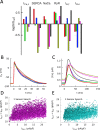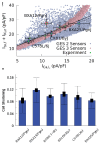The Ca2+ transient as a feedback sensor controlling cardiomyocyte ionic conductances in mouse populations
- PMID: 30251624
- PMCID: PMC6205808
- DOI: 10.7554/eLife.36717
The Ca2+ transient as a feedback sensor controlling cardiomyocyte ionic conductances in mouse populations
Abstract
Conductances of ion channels and transporters controlling cardiac excitation may vary in a population of subjects with different cardiac gene expression patterns. However, the amount of variability and its origin are not quantitatively known. We propose a new conceptual approach to predict this variability that consists of finding combinations of conductances generating a normal intracellular Ca2+ transient without any constraint on the action potential. Furthermore, we validate experimentally its predictions using the Hybrid Mouse Diversity Panel, a model system of genetically diverse mouse strains that allows us to quantify inter-subject versus intra-subject variability. The method predicts that conductances of inward Ca2+ and outward K+ currents compensate each other to generate a normal Ca2+ transient in good quantitative agreement with current measurements in ventricular myocytes from hearts of different isogenic strains. Our results suggest that a feedback mechanism sensing the aggregate Ca2+ transient of the heart suffices to regulate ionic conductances.
Keywords: cardiac electrophysiology; cardiac homeostasis; computational biology; mouse; physics of living systems; systems biology.
© 2018, Rees et al.
Conflict of interest statement
CR, JY, MS, AL, JW, AK No competing interests declared
Figures













Similar articles
-
Effects of taurine-magnesium coordination compound on ionic channels in rat ventricular myocytes of arrhythmia induced by ouabain.Biol Trace Elem Res. 2012 Jun;147(1-3):275-84. doi: 10.1007/s12011-011-9317-1. Epub 2012 Feb 5. Biol Trace Elem Res. 2012. PMID: 22311082
-
Effects of Salusin-β on action potential and ionic currents in ventricular myocytes of rats.Acta Physiol (Oxf). 2013 Jan;207(1):166-72. doi: 10.1111/j.1748-1716.2012.02475.x. Epub 2012 Sep 4. Acta Physiol (Oxf). 2013. PMID: 22846709
-
Transient receptor potential melastatin 4 channel inhibitor 9-phenanthrol inhibits K+ but not Ca2+ currents in canine ventricular myocytes.Can J Physiol Pharmacol. 2018 Oct;96(10):1022-1029. doi: 10.1139/cjpp-2018-0049. Epub 2018 May 28. Can J Physiol Pharmacol. 2018. PMID: 29806985
-
Apico-basal inhomogeneity in distribution of ion channels in canine and human ventricular myocardium.Cardiovasc Res. 2005 Mar 1;65(4):851-60. doi: 10.1016/j.cardiores.2004.11.022. Cardiovasc Res. 2005. PMID: 15721865
-
Cardiac systems biology and parameter sensitivity analysis: intracellular Ca2+ regulatory mechanisms in mouse ventricular myocytes.Adv Biochem Eng Biotechnol. 2008;110:25-45. doi: 10.1007/10_2007_093. Adv Biochem Eng Biotechnol. 2008. PMID: 18437298 Review.
Cited by
-
Metabolically driven maturation of human-induced-pluripotent-stem-cell-derived cardiac microtissues on microfluidic chips.Nat Biomed Eng. 2022 Apr;6(4):372-388. doi: 10.1038/s41551-022-00884-4. Epub 2022 Apr 27. Nat Biomed Eng. 2022. PMID: 35478228 Free PMC article.
-
Calcium-directed feedback control of the sinoatrial node robustness.Biophys J. 2023 May 2;122(9):1571-1573. doi: 10.1016/j.bpj.2023.03.040. Epub 2023 Mar 30. Biophys J. 2023. PMID: 37040769 Free PMC article. No abstract available.
-
A computational model of induced pluripotent stem-cell derived cardiomyocytes incorporating experimental variability from multiple data sources.J Physiol. 2019 Sep;597(17):4533-4564. doi: 10.1113/JP277724. Epub 2019 Jul 27. J Physiol. 2019. PMID: 31278749 Free PMC article.
-
Emergent activity, heterogeneity, and robustness in a calcium feedback model of the sinoatrial node.Biophys J. 2023 May 2;122(9):1613-1632. doi: 10.1016/j.bpj.2023.03.024. Epub 2023 Mar 21. Biophys J. 2023. PMID: 36945778 Free PMC article.
-
Co-expression of calcium and hERG potassium channels reduces the incidence of proarrhythmic events.Cardiovasc Res. 2021 Aug 29;117(10):2216-2227. doi: 10.1093/cvr/cvaa280. Cardiovasc Res. 2021. PMID: 33002116 Free PMC article.
References
-
- Bers D. Excitation-Contraction Coupling and Cardiac Contractile Force. Vol. 237. Springer Science & Business Media; 2001.
Publication types
MeSH terms
Substances
Grants and funding
LinkOut - more resources
Full Text Sources
Other Literature Sources
Medical
Molecular Biology Databases
Miscellaneous

